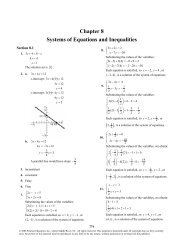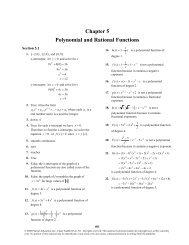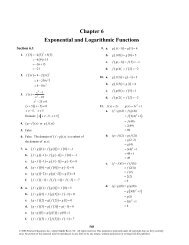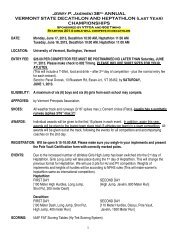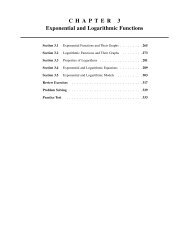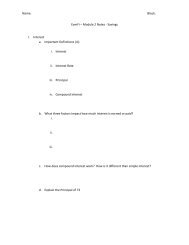C H A P T E R 2 Polynomial and Rational Functions
C H A P T E R 2 Polynomial and Rational Functions
C H A P T E R 2 Polynomial and Rational Functions
Create successful ePaper yourself
Turn your PDF publications into a flip-book with our unique Google optimized e-Paper software.
Section 2.5 Zeros of <strong>Polynomial</strong> <strong>Functions</strong><br />
Section 2.5 Zeros of <strong>Polynomial</strong> <strong>Functions</strong> 187<br />
■ You should know that if f is a polynomial of degree then f has at least one zero in the complex number system.<br />
■ You should know the Linear Factorization Theorem.<br />
■ You should know the <strong>Rational</strong> Zero Test.<br />
■ You should know shortcuts for the <strong>Rational</strong> Zero Test. Possible rational zeros<br />
(a) Use a graphing or programmable calculator.<br />
(b) Sketch a graph.<br />
(c) After finding a root, use synthetic division to reduce the degree of the polynomial.<br />
■ You should know that if is a complex zero of a polynomial f, with real coefficients, then is also a complex<br />
zero of f.<br />
■ You should know the difference between a factor that is irreducible over the rationals (such as ) <strong>and</strong> a factor that is<br />
irreducible over the reals (such as x ).<br />
■ You should know Descartes’s Rule of Signs. (For a polynomial with real coefficients <strong>and</strong> a non-zero constant term.)<br />
(a) The number of positive real zeros of f is either equal to the number of variations of sign of f or is less than<br />
that number by an even integer.<br />
(b) The number of negative real zeros of f is either equal to the number of variations in sign of fx or is less than<br />
that number by an even integer.<br />
(c) When there is only one variation in sign, there is exactly one positive (or negative) real zero.<br />
■ You should be able to observe the last row obtained from synthetic division in order to determine upper or lower bounds.<br />
(a) If the test value is positive <strong>and</strong> all of the entries in the last row are positive or zero, then the test value is an upper<br />
bound.<br />
(b) If the test value is negative <strong>and</strong> the entries in the last row alternate from positive to negative, then the test value is a<br />
lower bound. (Zero entries count as positive or negative.)<br />
2 x<br />
9<br />
2 n > 0,<br />
factors of constant term<br />
<br />
factors of leading coefficient<br />
a bi<br />
a bi<br />
7<br />
Vocabulary Check<br />
1.<br />
3.<br />
1. Fundamental Theorem of Algebra 2. Linear Factorization Theorem 3. <strong>Rational</strong> Zero<br />
4. conjugate 5. irreducible; reals 6. Descarte’s Rule of Signs<br />
7. lower; upper<br />
f x xx 6 2 2.<br />
The zeros are: x 0, x 6<br />
gx x 2x 4 3 4.<br />
The zeros are: x 2, x 4<br />
6. ht t 3t 2t 3it 3i<br />
The four zeros are: 3, 2, ±3i<br />
7.<br />
f x x 2 x 3x 2 1 x 2 x 3x 1x 1<br />
The five zeros are: 0, 0, 3, ±1<br />
f x x 5x 82 5. f x x 6x ix i<br />
The three zeros are: 5, 8, 8<br />
fx x 3 3x 2 x 3<br />
Possible rational zeros: ±1, ±3<br />
The three zeros are:<br />
x 6, x i, x i<br />
Zeros shown on graph: 3, 1, 1





